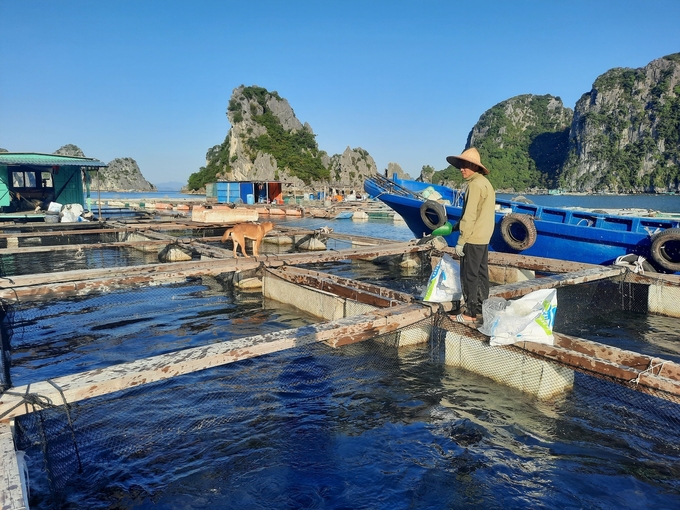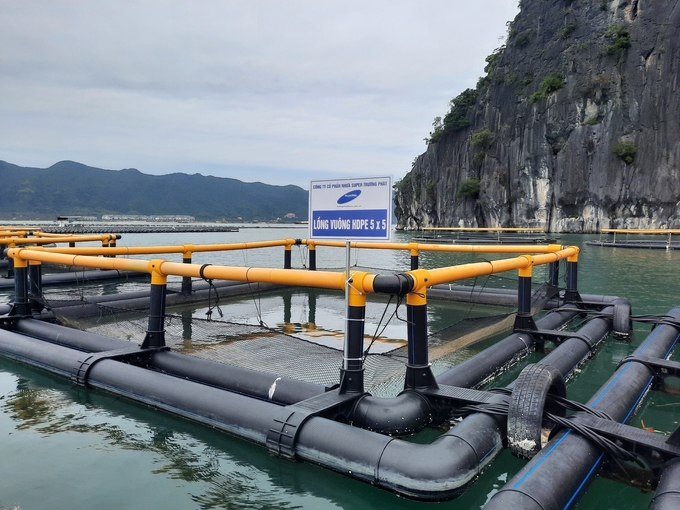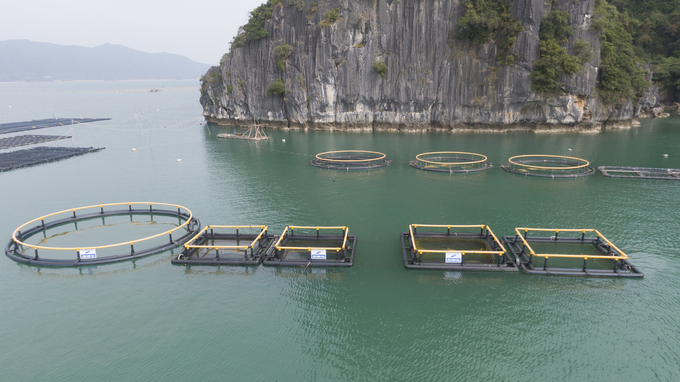May 16, 2025 | 10:35 GMT +7
May 16, 2025 | 10:35 GMT +7
Hotline: 0913.378.918
May 16, 2025 | 10:35 GMT +7
Hotline: 0913.378.918

Mr. Pham Van Duong's industrial mariculture area belonging. Photo: Nguyen Thanh.
Quang Ninh province features a diverse terrain consisting of the sea, hills, midlands and plains. Most notably, the province is home to many natural pools and bays, offering a favorable habitat for aquatic species to develop. These characteristics are a great foundation for the development of the aquaculture industry, including mariculture.
Quang Ninh province has over 6,000 square kilometers of water surface area, which provides an outstanding potential for cage aquaculture development that few regions in Vietnam have access to.
Quang Ninh also boasts a suitable farming environment with many phytoplankton, suitable depth, multiple enclosed areas, small flow rate, and protection from wind storms. Furthermore, the province is relatively far sources of oil, industrial waste, domestic wastewater among many other sources of pollutions.
Consequently, mariculture in Quang Ninh province has also developed strongly in recent years. The total area of mariculture in the province has reached over 2,200 hectares with approximately 15,000 cages, which is an increase of at least 6,000 cages compared to 2013. The cages are mainly concentrated in the cities of Van Don, Dam Ha, Hai Ha, and Cam Pha. The main mariculture objects in the province include grouper, yellowfin pompano, sea bass, bream, etc.
Cai Rong port in the center of Van Don district is the largest seafood producer in Quang Ninh province, where fishing vessels gather early in the morning to distribute fresh seafood to consumers inside and outside of the province. The sound of busy trading and traffic contrasts the previous quietness of the raging Covid-19 pandemic.
Mr. Pham Van Duong's grouper farming area, located fifteen minutes away from the mainland by train, is currently in the trading season. According to Mr. Duong, the price of grouper is higher and more stable compared to the Covid-19 period.
“During the days of Covid-19 pandemic, my farmed groupers are past their harvest but I could not sell them. Their price dropped to only 130,000 VND per kilogram at times. After the pandemic is controlled and all trading activities have recovered, our selling price of grouper has nearly doubled, reaching 245,000 VND per kilogram", shared Mr. Duong.
With 200 cages, each producing nearly 1 ton of fish, Mr. Duong earns an income in the billions.

Grouper is one of the primary mariculture objects in Quang Ninh waters. Photo: Nguyen Thanh.
According to Mr. Do Dinh Minh, Director of Quang Ninh province's Sub-Department of Fisheries, the province's total aquacultural output reached 161,000 tons in 2022, including 74,000 tons from exploitation and 87,000 tons from farming. Evidently, there was a strong shift from exploitation to farming in the structure of aquaculture in Quang Ninh.
Namely, exploitation output in 2014 accounted for 57% of the total aquacultural output, whereas farming output accounted for nearly 43%. By 2022, exploitation output dropped to 45.88%, and farming output accounted for 54.12% of the total aquacultural output.
Regarding marcultural seed production, the province has two main seed production facilities, Bac Viet seed production and aquaculture cooperative in Dam Ha district, and Phuong Anh private enterprise in Mong Cai city. Several other businesses have also invested in seed production technology. Maricultural seed production in Quang Ninh province currently meets approximately 35% of the market demand. Local businesses are planning to expand mariculture seed production facilities in Dam Ha district and Mong Cai city. The main breeding objects include sea bass, grouper, yellowfin pompano, etc.
By replacing floating materials in mariculture with new sustainable, pollution-free and environmentally friendly materials, Phat Co Cooperative in Van Don district is a pioneer in using HDPE floats and cages for mariculture. Additionally, Phat Co Cooperative has cooperated with Super Truong Phat Plastic Group to build a model of that combines mariculture and tourism.
The floating farm is built on an area of 5 hectares, including many smaller sub-sections such as the reception area with an area of 240 square meters and a capacity of at least 60 people; cages for visitors to swim and bathe in the sea; Check-in raft with an area of 16 square meters. Addditionally, there is a square cage system with an area between 16 and 30 square meters, a round cage system with a 12-meter diameter for raising catfish, pompano, sea bass.

The HDPE mariculture area belonging to Phat Co Cooperative. Photo: Van Nguyen.
This location serves as a pilot farming area for new aquatic species with high economic value and adaptability. Additionally, a demonstration model of floating materials in combination with experience tourism is installed within this perimeter.
Visitors can exchange experiences in designing, operating and managing farming models. In addition, visitors can experience raft fishing and enjoy the products that they catch and process.
Ms. Nguyen Thi Hai Binh, CEO of Super Truong Phat Group, believes that mariculture in combination with eco-tourism is the suitable development orientation for a country with a long coastline such as Vietnam.
Developed countries around the world have replaced traditional production materials in mariculture to target tourism, create a sustainable environment, prevent toxic substances from entering the mariculture habitat, and promote the growth of aquatic species.
"We have the opportunity to combine tourism and mariculture to create a new industry, which is recreational fishing. China and Taiwan have also been experimenting with recreational fishing on HDPE and Composite cages for a fee. Accordingly, five to seven farming households can combine to form a small tourist village that welcomes both domestic and foreign tourists. This combination will also help promote maricultural products and increase farmers' income", Ms. Binh remarked.
According to Mr. Do Dinh Minh, the current output of mariculture in Quang Ninh province is only at 60%.
"However, with each mariculture cage produceing 600 kilograms of fish, 15,000 cages and the average selling price of 180,000 VND per kilogram will net farmers an annual revenue of nearly 2,000 billion VND", Mr. Minh emphasized.
The output and revenue from mariculture as well as cage farming in Quang Ninh can increase exponentially if stakeholders innovate the production and management process.

Quang Ninh's mariculture has recovered rapidly post-Covid-19. Photo: Van Nguyen.
Quang Ninh's seafood consumption market has the advantage of sharing border gates with China, seaports, and ASEAN connections. Additionally, there is a local available and abundant labor force ready to meet the needs of mariculture.
Several businesses have planned to engage in concentrated cage farming on a 300 hectares area in the waters of Cam Pha City and Mong Cai City. Accordingly, the primary products will include grouper and yellowfin pompano. The output is expected to range from 2,000 to 3,000 tons per year, with a success rate of at least 80%.
According to Assoc. Prof. Dr. Nguyen Huu Dung, Chairman of the Vietnam Mariculture Association, the development of Quang Ninh's mariculture is still in its infancy. As a result, the province can plan for large-scale production immediately from the beginning. Furthermore, the province can transition from traditional to industrial mariculture with a focus on businesses, from inshore to off-shore farming. The province can also plan for an appropriate rearing density to support the strong development of aquatic products, with a focus on marine species.
Quang Ninh province should establish a maricultural production linkage model from the supply of materials, parent breeds, offspring, commercial products to product consumption in order to improve production value and ensure product traceability. On the other hand, concentrated mariculture areas need to be formed as the focal point of linkage model to reduce intermediaries.
The change from summer to autumn and from autumn to winter renders farmed fish more susceptible to diseases. Namely, the temperature difference between seasons, between day and night weaknes the fish's immunity system. Consequently, producers need to take preventive measures such as supplementing vitamins and minerals for fish.
Quang Ninh province's aquaculture experienced a significant growth between 2013 and 2022. Various new technologies and farming objects with high economic value have been put into production, resulting in high economic efficiency as well as improved productivity, output and value for aquacultural products.
Translated by Nguyen Hai Long

(VAN) Cold-barn systems efficiently manage environmental and temperature conditions, which aids in the prevention of respiratory diseases in pigs and protects them from the vectors that transmit African swine fevers.

(VAN) To tackle challenges, the project 'Addressing key technical bottlenecks in the grouper supply chain in Vietnam' has been underway since 2024.

(VAN) The project 'Disease-Resilient and Sustainable Cassava Production Systems in the Mekong Region', funded by the Australian Center for International Agricultural Research (ACIAR), is being implemented from 2024 to 2028.

(VAN) Data from 10,000 farming households will help professionalize production organization and support the implementation of the One Million Hectares Program for High-Quality, Low-Emission Rice Cultivation.

(VAN) FAO Director-General QU Dongyu marks International Day of Plant Health at NENA conference.

(VAN) Deputy Minister of Agriculture and Environment Hoang Trung affirmed that floriculture and ornamental plants are a growing industry that receives significant global attention.

(VAN) The three staple crops dominating modern diets – corn, rice and wheat – are familiar to Americans. However, fourth place is held by a dark horse: cassava.